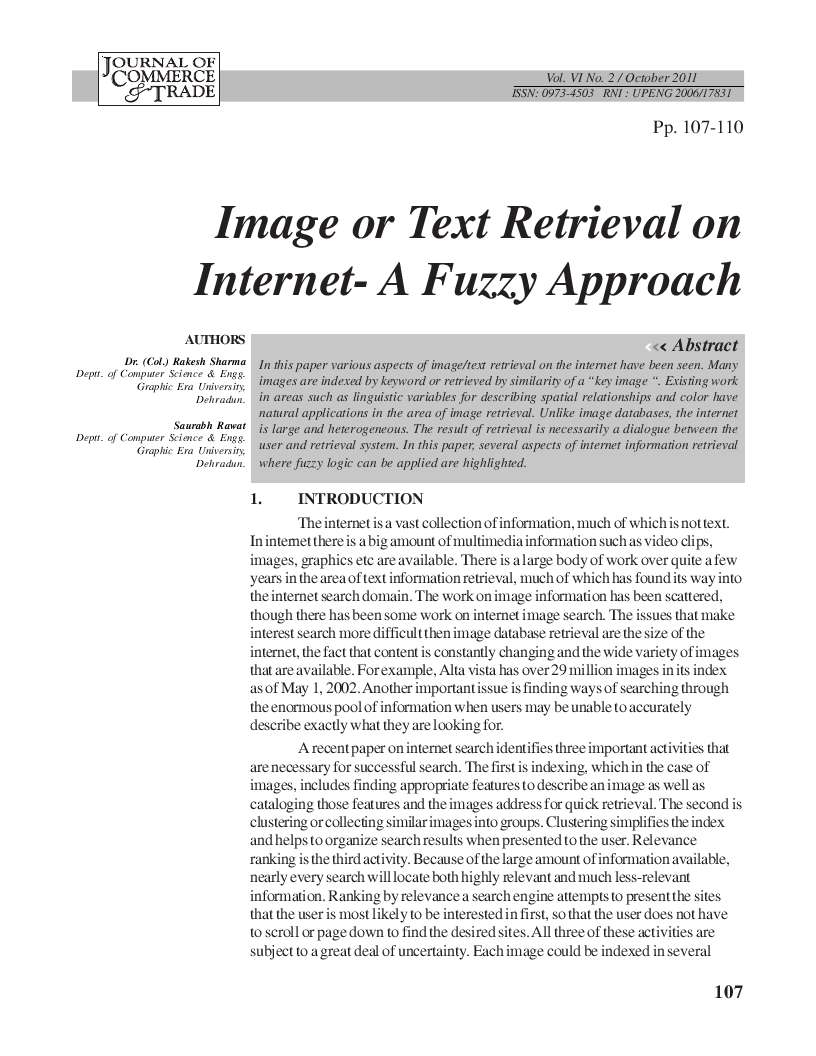Image or Text Retrieval on Internet - A Fuzzy Approach
DOI:
https://doi.org/10.26703/jct.v6i2.342Keywords:
Image, Text, Internet, RetrievalAbstract
In this paper various aspects of image/text retrieval on the internet have been seen. Many images are indexed by keyword or retrieved by similarity of a “key image “. Existing work in areas such as linguistic variables for describing spatial relationships and color have natural applications in the area of image retrieval. Unlike image databases, the internet is large and heterogeneous. The result of retrieval is necessarily a dialogue between the user and retrieval system. In this paper, several aspects of internet information retrieval where fuzzy logic can be applied are highlighted.
Downloads
Metrics
References
AltaVista (The number of available images is determined by clicking on the “image” tab and searching for the wild card “*”).
Bacza-Yates, R. and Ribciro-Neto, B. Modern Information Retrieval, Addison-Wesley, Reading MA,1999
Boskovitz, Victor and Hugo Guterman “An Adaptive Neuro-Fuzzy System for Automatic Image Segmentation and Edge Detection,” IEEE Transactions on Fuzzy Systems vol. 10, no. 2, April 2002,pp, 247-262.
Brunelli, R., and O.Mich, “Histogram Analysis for Image Retrieval,” Pattern Recognition vol. 34, 2001 pp. 1625-1637.
Chang, Shi-Fu, John R. Smith, Mandis Beigi, and Ana Benitez, “Visual Information Retrieval from Large Distributed Online Repositories,” Communications of the ACM, vol. 40, December 1997, pp. 63-71
Ding, L. and M. Mukaidono, “Satisfaction Measure for Result in Fuzzy Reasoning and Retrieval—An Attempt towards the Application of Fuzzy Logic as the “Brainware” of the internet,” in Proceedings of the IFSA World Congress and 20th NAFIPS International Conference, 2001, pp. 2200-2205.
J.C. Dunn, “ A Fuzzy Relative of the ISODATA Process and Its Use in Detecting Compact Well- Separated Clusters,” J. Cybernetics, vol. 3, 1973, pp, 32-57, Reprinted in Fuzzy Models for Pattern Recognition, J.C. Bezdek and S.K. Pal, eds., IEEE Press, 1992.
Flickner, M.et.al, “Query by Image and Video Content: The QBIC System,” Computer, vol.28, September 1995, pp, 23-32.
Frigui, Hichem, Nozha Boujemaa and Soon-Ann Lim, “Unsupervised Clustering and Feature Discrimination with Application to Image Database Categorizaton, “ in Proceeding of the IFSA World Congress and 20th NAFIPS International Conference, 2001, pp, 401-406.
Jansen Bernard J. , abby Goodrum and Amanda Spink, “Searching for multimedia: analysis of audio, video and image Web queries,” World Wide Web, vol. 3,2000, pp, 249-254.
Kobayashi, Mei and Koichi Takeda, “Information Retrieval on the web,” ACM computing Surveys, vol.32, no.2, June 2000, pp, 144-173.
Mukherjea, Sougata, Kyoji Hirata and Yoshinori Hara. “AMORE: A World Wide Web image retrieval engine,” World wide Web, vol.2, 1999, pp, 115-132
Rodriguez, I.G., J. Lawry and J.f. Baldwin, “A Linguistic Clustering Algorithm for Fuzzy Prototype Induction,” in Proceedings of the IFSA World Congress and 20th NAFIPS International Conference, 2001, pp, 1816-1821.
Smith, John R, and Shi Fu Chung, Searching for Images and Videos on the World Wide Web, Technical report #459-96-25. Department of Electrical Engineering and Center for Image Technology for New Media, Columbia University, August 19, 1996.
Zamir, Oren and Oren Etzioni, “Web Document Clustering: A Feasilbility Demonstration,” in Proceedings of ACM SIGIR’98, Melbourne Australia, 1998, pp, 46-54.

Downloads
Published
How to Cite
Issue
Section
License
Copyright (c) 2011 Dr. (Col.) Rakesh Sharma, Saurabh Rawat

This work is licensed under a Creative Commons Attribution 4.0 International License.














